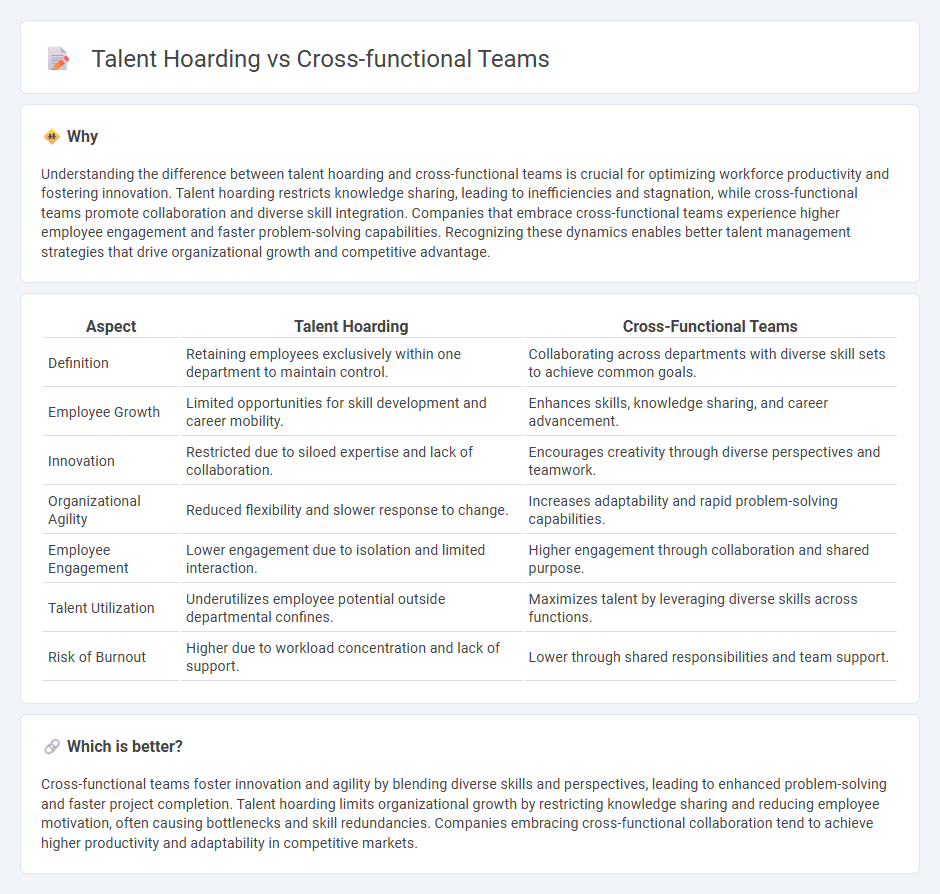
Talent hoarding limits organizational growth by confining skills within specific departments, reducing collaboration and innovation. Cross-functional teams enhance productivity and problem-solving by integrating diverse expertise across various roles. Discover how balancing talent allocation fosters a more dynamic and competitive workforce.
Why it is important
Understanding the difference between talent hoarding and cross-functional teams is crucial for optimizing workforce productivity and fostering innovation. Talent hoarding restricts knowledge sharing, leading to inefficiencies and stagnation, while cross-functional teams promote collaboration and diverse skill integration. Companies that embrace cross-functional teams experience higher employee engagement and faster problem-solving capabilities. Recognizing these dynamics enables better talent management strategies that drive organizational growth and competitive advantage.
Comparison Table
| Aspect | Talent Hoarding | Cross-Functional Teams |
|---|---|---|
| Definition | Retaining employees exclusively within one department to maintain control. | Collaborating across departments with diverse skill sets to achieve common goals. |
| Employee Growth | Limited opportunities for skill development and career mobility. | Enhances skills, knowledge sharing, and career advancement. |
| Innovation | Restricted due to siloed expertise and lack of collaboration. | Encourages creativity through diverse perspectives and teamwork. |
| Organizational Agility | Reduced flexibility and slower response to change. | Increases adaptability and rapid problem-solving capabilities. |
| Employee Engagement | Lower engagement due to isolation and limited interaction. | Higher engagement through collaboration and shared purpose. |
| Talent Utilization | Underutilizes employee potential outside departmental confines. | Maximizes talent by leveraging diverse skills across functions. |
| Risk of Burnout | Higher due to workload concentration and lack of support. | Lower through shared responsibilities and team support. |
Which is better?
Cross-functional teams foster innovation and agility by blending diverse skills and perspectives, leading to enhanced problem-solving and faster project completion. Talent hoarding limits organizational growth by restricting knowledge sharing and reducing employee motivation, often causing bottlenecks and skill redundancies. Companies embracing cross-functional collaboration tend to achieve higher productivity and adaptability in competitive markets.
Connection
Talent hoarding limits resource availability and stifles knowledge sharing, which impedes the effectiveness of cross-functional teams designed to leverage diverse skills. Cross-functional teams thrive on collaborative environments where expertise is openly shared to drive innovation and problem-solving. Overcoming talent hoarding practices enhances team agility and overall organizational performance by maximizing skill utilization across departments.
Key Terms
Collaboration
Cross-functional teams enhance organizational agility by integrating diverse skill sets from multiple departments to achieve common goals, which contrasts sharply with talent hoarding where key skills remain siloed, limiting innovation and efficiency. Collaboration within cross-functional teams drives knowledge sharing, accelerates problem-solving, and improves project outcomes by leveraging varied perspectives and expertise. Discover more about fostering effective collaboration and overcoming talent hoarding challenges in dynamic workplaces.
Knowledge Sharing
Cross-functional teams enhance organizational agility by fostering diverse expertise collaboration, breaking down silos that promote knowledge sharing and innovation. Talent hoarding limits information flow and stifles team growth, impeding collective problem-solving and reducing overall performance. Explore how shifting from talent hoarding to cross-functional collaboration can unlock your team's full potential.
Resource Allocation
Cross-functional teams enhance resource allocation by promoting collaboration across departments, ensuring that diverse skills and expertise are utilized efficiently. Talent hoarding, conversely, limits resource allocation by concentrating specialized knowledge within silos, reducing overall organizational agility and innovation. Explore strategies to optimize resource allocation by fostering cross-functional teamwork and minimizing talent hoarding.
Source and External Links
What Are Cross-Functional Teams? (Benefits and Examples) - Indeed - Cross-functional teams are groups of individuals from different departments collaborating on a specific project, enhancing organizational success through diverse perspectives and expertise.
Cross-Functional Team | Definition, Collaboration & Examples - These teams combine members with different functional expertise and similar authority levels to achieve synergy, producing outcomes greater than individual efforts could.
Cross-functional team - Wikipedia - Cross-functional teams draw from diverse organizational areas to make strategic, tactical, and operational decisions, requiring clear communication of complex information for effective collaboration.
 dowidth.com
dowidth.com